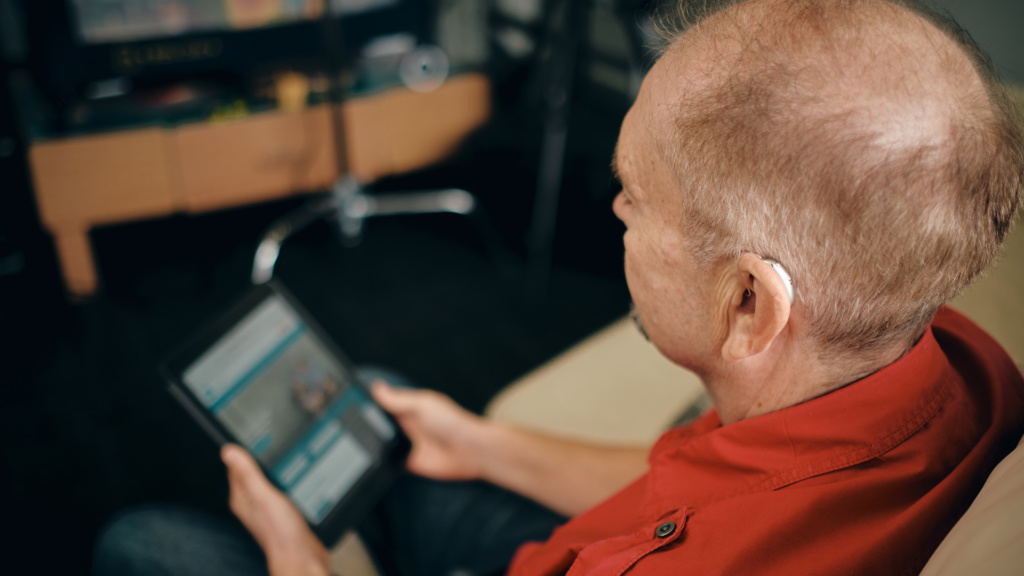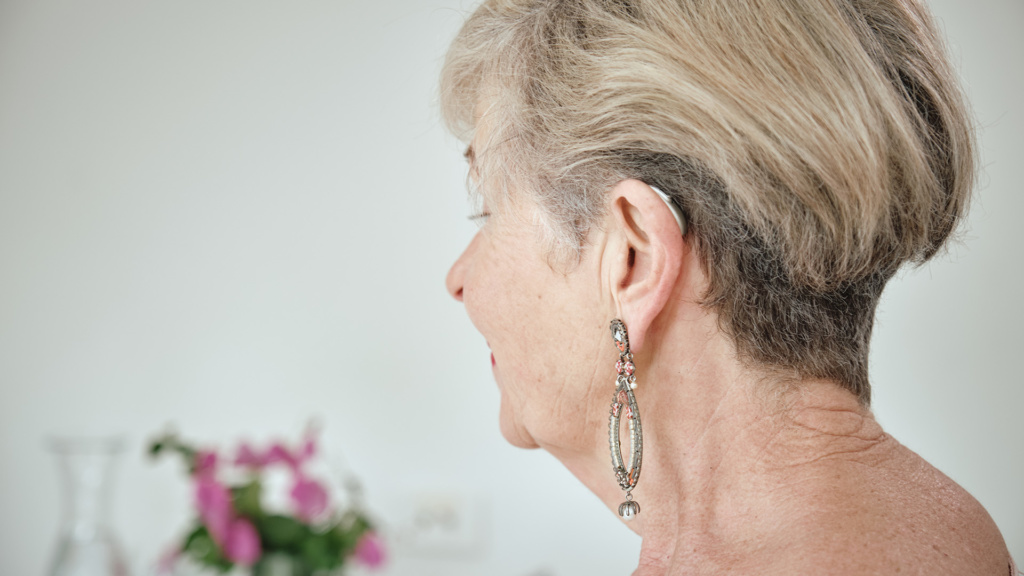As we are not aligned to any one brand or manufacturer, Hear and Say can offer you trusted and unbiased advice and options. Our experienced audiologists will provide clear recommendations and information, so you feel comfortable in making decisions about which device is right for you.
We are currently experiencing internet and phone issues in some of our centres. For all enquiries, please contact mail@hearandsay.com.au.
Hearing aids
It can take up to 10 years to do something about hearing loss after noticing a change1
It takes about 30 days for someone to get used to wearing their hearing aids2
Hearing loss can be preventable and treatable. Find the best solution for you.
Improving your hearing can help many aspects of life. It can reduce isolation, improve communication and keep you connected with your loved ones. Working out which hearing aid is the best fit for you can feel overwhelming, especially with so much information available online.

Do you need a hearing aid?
There are a few common signs that may indicate you are suffering from hearing loss and need a hearing aid.
- You have trouble hearing the television
- You struggle to follow conversation in a louder environment
- You have trouble hearing people over the phone
If you are experiencing any of the above symptoms, it may be worth booking in a hearing screening.
We're here to help
If you are experiencing signs of hearing loss, we’re here to help. Book an appointment to see our experienced team for a hearing test. Fill out the form below to select your preferred day and time alongside your contact details and a member of our team will be in touch within 24 hours.
Book a hearing test
Types of hearing aids
Hearing aid technology has improved greatly in the last five to 10 years. Hearing aids are now extremely small and discrete and come in a range of sizes and colours to best match your hair and skin colouring.
Styles of hearing aids
Hearing aids come in a range of models including those which sit in the ear, in the ear canal or behind the ear. What’s most suitable for you depends on your level and type of hearing loss, together with your budget and lifestyle. The different types of hearing aids include:
- In the Ear (ITE)
- In the Canal (ITC)
- Completely in the Canal (CIC)
- Invisible in the Canal (IIC)
- Behind the Ear (BTE)
- Receiver in the Canal (RIC)

Helping you choose a hearing aid
Hearing aid technology
From Bluetooth streaming and tinnitus relief to discrete sizing, hearing aid technology has improved significantly in recent years. Features available can include:
- Direct streaming to your mobile phone, TV, tablet, car navigation system and more via Bluetooth
- Automatically adapting to different environments – for example, when you move from a quiet car into a noisy cafe)
- Speech enhancement features –for example, directional microphones for focusing on speech sources and reducing background noise
- Background noise reduction
- Rechargeability
Hearing aid features and accessories
Additional technologies to supplement your hearing aids, known as assistive listening devices can maximise your hearing and communication in different situations. These vary depending upon the hearing aid models and include:
- TV streaming devices
- Remote microphone systems to overcome hearing challenges when in noisy environments, and at a distance
- Smart phone apps to adjust your hearing aid settings (such as volume and different programs) as needed in different situations and allow for remote fine-tuning capabilities

News
Better Hearing Makes World of Difference
Getting used to your hearing aid
The rewards are plenty with the appropriately fitted hearing devices. However, it can take some time to get used to your hearing aids, as your brain gets used to new sounds it may have forgotten about – not to mention getting used to wearing them!
Tips to adjusting to your hearing aids
- Persevere: don’t feel discouraged if it takes some time to get used to your hearing aids, as this is completely normal. It can take someone about 30 days to get used to their hearing aids, regardless of their history using hearing aids – known as the acclimatisation period.3
- Consistency is key. Build up to wearing your hearing aids all waking hours. At first, start with a few hours and add a few more hours in each day with the aim to wearing your devices full time in the first few weeks after fitting. If you are not comfortable wearing your new hearing devices full time in the first few weeks please book an appointment to have a review of your hearing aid. Your audiologist can help by adjusting your hearing aids to maximise comfort and sound quality.
- Practice listening to different sounds in your environment. Starting to hear more sounds around you can be overwhelming initially.
- It’s quite common to have some irritation or itchiness in or around your ear when you first start wearing your hearing aids – this should disappear over time.
- Visit your audiologist for follow-up appointments to ensure your hearing aids are continuing to best meet your needs.
- Ask lots of questions! Your audiologist is more than happy to help out along your new hearing journey.
Specialist speech pathology
Specialised speech pathology known as auditory learning focuses on enhancing your hearing and listening skills when using your hearing aid. Your speech therapist will guide you to get the most from your device to achieve your hearing and communication potential. Some aspects of speech pathology can be practiced at home, such as via apps, and others are best to work through with a trained professional to ensure goals are being set and you are making progress.


Hearing aid maintenance tips
To keep your hearing aids working effectively, there are things you can do to ensure the sound is clear, and your hearing aid lasts as long as possible. It’s important to keep your hearing aid regularly maintained, including:
- Clean regularly to avoid build-up of grime
- Keep your hearing aid dry
- Try and keep your hearing aid free of earwax, dust and dry skin
- Pop your hearing aid on after you’ve applied makeup or hair products
Replacing your hearing aid
If you're wondering if you need new hearing aids, there are a few different things you may wish to consider: These include:
- You've had your current hearing aids for over five years
- Your level of hearing loss has changed
- Your current hearing aids are broken and not able to be fixed
- The benefits of upgrading to new technology (e.g. Bluetooth)
We are a registered provider
Hear and Say is a registered National Disability Insurance Scheme (NDIS) provider. Hear and Say is also an Australian Government Hearing Services Program provider. If you hold a pension or Department of Veterans Affairs (DVA) card, you may be eligible for subsidised services.
Hearing Aid FAQs
Hearing aids are small devices that you wear behind your ear which amplify or increase sound for people with hearing loss. Hearing aids have a microphone that receives sound waves converting them into a digital signal. Other components include an amplifier, speaker and battery.
A hearing test will help determine if you need a hearing aid by looking at the softest sounds you can hear across a range of pitches. Hearing equal to or better than 20 dB hearing loss is considered within normal limits. Even people with very mild hearing loss can gain significant benefit from an appropriately fitted hearing aid particularly for listening to soft speech and hearing in noise.
Hearing aids are powerful devices that can help improve your hearing and, as a result, improve your overall quality of life. With constantly evolving and advancing technology, the ways that hearing aids work to help you hear are improving. Hearing aids can help when you have a permanent hearing loss by making speech and sounds in your surrounding environment louder so that you can hear them.
There are a range of hearing aid manufacturers. Your audiologist will recommend the brand and type that is suited to your hearing loss. Hear and Say is independent of all brands – unlike many other hearing aid clinics which are owned by manufacturers.
There are lots of different styles of hearing aids suitable to various types and severity of hearing loss, as well as your personal goals and needs.
The cost of hearing aids range depending on a number of factors including features, style, brand and more. Prices typically range from around $2,000 up to approximately $8,000 per pair.
If you have private health insurance, many insurers will fully or partially cover the cost of your hearing aid. It’s important to check your cover to see what’s included by your insurer and policy level.
Following a hearing test, your audiologist will recommend a hearing aid that is best suited to your hearing loss and needs. We don’t recommend buying a hearing aid online or from an advertisement, as it is rarely a case of one-size-fits-all.
Hear and Say is an Australian Government Hearing Services Program provider. This means if you are a pensioner or Department of Veterans Affairs (DVA) card holder, you could be eligible to access services that are subsidised by the government.
As soon as you put your hearing aids on, sounds will be amplified. You will however need to give your brain time to adjust to these new sounds that you may not have heard for quite some time. Generally it takes at least around four to six weeks of consistent use to get the most benefit from hearing aids.
If your hearing aids get wet, there is no need to panic as they are generally resistant to a level of dirt, dust, sand and water.
People often query the benefit of wearing two hearing aids. Whilst every person’s hearing loss is different, if you’re experiencing hearing loss in both ears, two hearing aids are better than one. Two hearing aids helps with better sound localisation, ability to hear with noise in the background, and decrease auditory fatigue in noise.
Hearing aids can help when you have a permanent loss by making speech and sounds around you clearer so that you can understand better. Implantable hearing devices, such as a cochlear implant, are suitable for people of all ages with significant hearing loss when hearing aids are no longer enough.
If you wear your hearing aids consistently, they can help to actively prevent the further deterioration of your hearing by keeping your brain’s auditory pathways stimulated. The more you wear your hearing aids the more benefit you will get from them.
The cost of hearing aids are not covered by Medicare, however if you hold a pension or Department of Veterans Affairs (DVA) card, you may be eligible for subsidised services under the Australian Governments Hearing Services Program. Hear and Say is an Australian Government Hearing Services Program provider. Hearing aids can also be covered in part by private health insurance.
Get the latest updates...
Keep up-to-date with our latest news, information, events and more.
"*" indicates required fields
References
1 Understanding auditory deprivation: Why untreated hearing loss is bad for your brain. (2021, July 6). Healthy Hearing. https://www.healthyhearing.com/report/46306-Hearing-loss-auditory-deprivation
2 Changes in Hearing Aid Benefit Over Time: An Evidence-Based Review. (2021, August 20). Audiology Online. https://www.audiologyonline.com/articles/changes-in-hearing-aid-benefit-939
ABN 32 058 430 069
Acknowledgement of country
We acknowledge the Traditional Custodians of all the lands on which we meet, work and live, and pay our respect to Elders, past, present and emerging. We respect their continuing culture and the contributions Aboriginal and Torres Strait Islander peoples make through their resilience and strength.
Privacy Policy | Accessibility Statement
Copyright © 2024 – All Rights Reserved
29 Nathan Avenue, Ashgrove Qld 4060 ABN 32058 430 069
Acknowledgement of country
We acknowledge the traditional custodians of all the lands on which we meet, work and live and recognise that this land has always been and always will be Aboriginal and Torres Strait Islander land.
- Privacy Policy
- Contact Us
- Copyright © 2024 - All Rights Reserved






